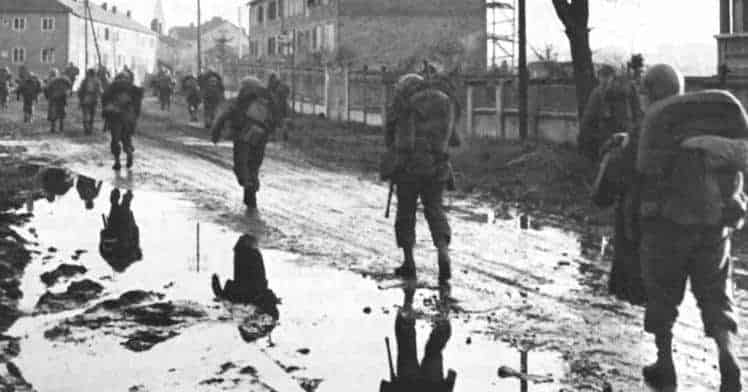Of the American combat troops which served on the continent of Europe during the Second World War about 15% were frontline infantry. They served in squads, led by a junior officer and experienced sergeants, slogged through and slept in mud and snow, maintaining contact with the enemy, taking and holding ground. In previous American wars volunteer units were often composed of men from the same communities, but not in World War II, when a typical squad included members from all over the United States. When they first arrived in Europe the squads had often been together since their basic infantry training, but casualties and replacements inevitably changed their composition.
The combat infantryman, and for the most part their immediate superiors at the front, had little information about the overall situation of the war. Their war was what they encountered. News about the war was disseminated in newspapers such as Stars and Stripes, but few found their way to the front, and when they did they were often several weeks old. The infantrymen didn’t know the reasons why they had to fight and too often die for a particular hill, or seemingly useless French farm or village, they simply had to do what they were told.

Here are ten examples of what life was like for the combat infantryman of the Second World War.

Getting there
The Americans who served in the Army in Europe were recruited and trained at various bases and camps in the United States before being sent to points of embarkation near major East Coast ports for transport to Europe. Some embarkation ports were near major military installations, such as Norfolk, Virginia. Others were encampments such as Camp Myles Standish, outside of Boston, Massachusetts. Camp Standish was both a staging area for embarking troops and a prisoner of war camp. It was capable of processing an entire division for embarkation in a single day, but it seldom did due to the nature of shipping schedules from the Port of Boston.
The Army considered its use as an embarkation point a secret, and so warned the young soldiers when they arrived. While remaining at the camp, soldiers were told that they would be allowed to leave the facility and visit Boston, or Providence and other locations. Transportation was provided, and troops were not allowed to wear unit insignia outside the camp, nor discuss their unit or the camp with civilians. Impressed with this secrecy and their implied importance, many of the soldiers discovered that civilians in Boston knew of the camp, its purpose, and the fact that the soldiers being temporarily held there were on their way to Europe.
The American army traveled to Europe by ship, and by a wide variety of ships including troop transports designed and built for the purpose, Liberty ships, converted freighters, and the great ocean liners of the Allies. The liners had been gutted and great rows of tiered bunks filled their hulls. SS America, renamed USS West Point, could carry nearly eight thousand troops and its speed meant it could sail without escorts, capable of outrunning German U-boats. Aboard ship, the troops, most of whom had never been on a ship before, endured crowded conditions, jammed mess halls with waiting lines of up to an hour, seasickness, and boredom.
American troops disembarked in ports in England and Scotland, Iceland, and North Africa, and as the war went on, directly on the continent in Marseille and Toulon in the Mediterranean, and Cherbourg and other Channel ports. They were marched or trucked to holding areas, where they encamped in accordance with their division procedures to await the arrival of their heavy equipment and logistics facilities. Despite these encampments being located in secured areas, the army being the army demanded sentries around them, and sufficient make work was scheduled to give the men something to do. The infantryman’s first encounter with the French or Italians usually took place near these camps.
The young Americans soon learned the essential words in French to address their immediate concerns, such as mademoiselle, vin, biere, and other useful phrases and terms. Depending on the season in which they arrived, the camps could be pleasant or miserable; for example, Mediterranean fall sunshine or the bitter Mistral winds of winter. While waiting for their orders for deployment the food was at least usually hot and plentiful, opportunities to fraternize with the welcoming French were frequent, and the mail arrived regularly bringing news from home. It was a lull before the storm, since more and more infantrymen were needed at the front.

